This week, I went to Food Lifeline and volunteered in their big warehouse.
Warning: This blog article has nothing to do with Starbucks … Now that I have that out of the way, I shall continue:
In July, I volunteered with Food Lifeline at the Bite of Seattle event. I mentioned it in passing in this article here, though didn’t write a blog post about it. I had so much fun at the Bite of Seattle, that I decided I would sign up to volunteer with Food Lifeline again. You can see a picture of me here manning the Food Lifeline donation box at the Bite of Seattle. Last Wednesday evening (August 8, 2012), I went to their main office and warehouse space in Shoreline, Washington for another round of volunteering. Here’s the front of their building:
Some of you may remember that earlier this year, you saw that the postman put a blue plastic sack in your mailbox with the message “Stamp Out Hunger.” The Stamp Out Hunger food drive is actually a national event. I learned that is timed in the spring of each year because giving drops during that time, however the need for food starts to go up. As children finish their school year, they shift away from having meal programs in schools and parents may need more food at home.
The many many bags full of donated food then get distributed to agencies that sort, filter, and repack the food for distribution to food banks, and meal programs. That’s how Food Lifeline ended up with numerous extremely large boxes, full of bags of food. Here are the boxes we had to sort through:
Back to those blue bags full of food: One thing I learned is that many people put nearly inedible stuff into those blue plastic donation bags. I saw cans of soup that were expired by over five years. I saw half open bags of pastas. People toss in some strange food items. And people toss perishables into those blue bags. At one point during my work, we ripped open a blue bag that had half a bag of potatoes.
If you decide to donate to a food drive, here are some loose guidelines to think about: All the food you donate should have an ingredient label. Because of concerns over food allergies, foods that don’t have an ingredient label on them are simply tossed into the trash. Do not donate perishables. Don’t give cans of beer or anything alcoholic. Some of the food programs that receive the donations may be associated with recovery centers. Don’t donate such extremely old food that you wouldn’t touch it yourself. I saw one box of half eaten pasta-like product that had a Pay ‘n Save price tag on it. There hasn’t been a Pay ‘n Save in Seattle in decades. Don’t donate half-eaten food. Don’t donate crushed or damaged canned items.
One team of volunteers lifted bags of food out of those big boxes and placed them on numerous tables where teams of people ripped them open to sort their content. I was placed with the team of people who ripped open the bags and sorted. I tossed out things like crushed and damaged cans, grossly expired food, and food with no labels. (It was surprising to me how often I saw that). Then I sorted dry items (e.g., pasta) from canned and liquid items. Also, the many cans of pet food that are donated (yes, they get tons of pet food!) are sorted separately and are not stored with human food items. The sorted food items (for human consumption) that had been “filtered” by my teams then were placed on a long conveyor belt. At the end of the conveyor belt, another team of volunteers carefully packed like items together in boxes. The final boxes are what end up at food banks and meal programs.
Here’s an action shot of the conveyor belt:
If it’s not obvious, I had a blast. I met other friendly volunteers, and learned more about food donation than I ever knew before! The group of volunteers for that’s night work appeared to be roughly 25 people. There were large scales on the premises, and the volunteer director told us that we processed 6,980 pounds of food that evening. About 70 to 80 percent of all the food that Food Lifeline distributes comes from donations, such as food drives and donation bins in strategic locations like grocery stores. If you want to donate to Food Lifeline, here is information how to do so.
At one point in the evening, I noticed a bag of Starbucks Guatemala Antigua whole bean coffee make its way down the conveyor belt. It had come from one of the other tables of volunteer sorters. I grabbed my phone and took a quick photo of that too. Spot the coffee: 🙂
By the way, the Food Lifeline warehouse is huge:
Thank you for patiently reading about my volunteering experience! I will go back to my regular Starbucks programming soon. 😉
Last but not least, Starbucks does have a Community Service website that both customers and partners can register at. This Food Lifeline event was not related to Starbucks in any way, but I want to point out the Community Service website in case my readers are interested.
Thanks again for bearing with me through a non-Starbucks article!
Related posts
10 Comments
Leave a Reply Cancel reply
You must be logged in to post a comment.
Sponsors
Recent Comments
- DEVIN on Compostable Straws Land in Seattle Starbucks Stores
- coffeebeanz on Why do you go to Starbucks less often? (If that’s true for you)
- Willi on You can now buy a Siren statue: $6,000
- Willi on A major revamp of your drink recipe: Testing syrup extracts and cane sugar
- Skip on Why do you go to Starbucks less often? (If that’s true for you)



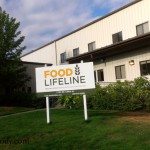
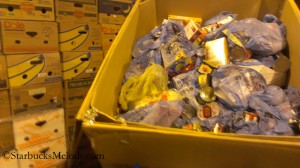
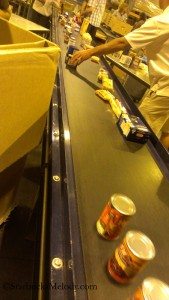
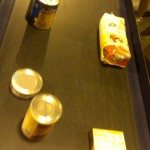
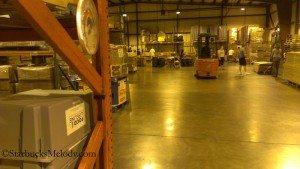



Melody I am so glad you wrote this piece. Every May when we get the post card from the postal service we donate food. I find it interesting that so few people on our block put out bags for the postal people. This warehouse seems huge in comparison to facilities around us. Our food banks have some of the same issues you have experienced when you volunteered. Thanks.
Great work Melody
I recently watched an episode of Our America with Lisa Ling about food banks and the recession. They were talking about the increase of use and that the demographics are shifting. I’m glad that food banks are there when we need them.
I love the fact that you’re sharing your volunteerism! I always wanted to join Starbucks for one of their volunteering events but I was usually signed up to do something else. Keep it up.
Such a great cause! I need to volunteer my time since money is tight! Always try to do one or the other.
Thanks Melody for volunteering with Food Lifeline and for sharing this fantastic article! We love our volunteers!
Thank you for sharing this story 🙂 I hope people start thinking harder about what they’re donating – I really appreciate that you outlined what good and bad choices are for food donation. I remember when I was in Real Estate my Ex- Fiance and I had attended a Food Drive fundraiser and bought a high priced table dinner for 7 people. Within months the economy tanked (that first serious dip 5 years back) and then I was the one standing in line for grocery donations and praying we made rent. What was in those bags of food was vital for my family. Old, outdated opened food would not have answered my prayers. Oi veh. I also wanted to thank you for providing the links for donating. Community outreach is important and the food banks and food drives strike an especially soft spot in my heart. I remember what it was like to stand in that line so I’m always careful to put solid goods in the bins/donation bags. Thank you Mel for giving back to the community 🙂
Such a good cause. I’ve had a friend or two that needed their services, and when they got back on their feet, they paid back much in the way of monetary donations. They were very glad to have that lifeline. Good work, Melody!
I volunteered at a homeless shelter for several years watching children under five while their parents attended a mandatory parenting class.
@Rich – Thank you for being a volunteer.
On a related note- my local SB store is having a food drive now until September 6, however, I just noticed the basket yesterday and mentioned to some partners and the ASM that the location and sign are not well placed and suggested moving it. When they have done this before, it was near the register. Hopefully, they will move it. Unfortunately, so far I was the only one that put donations in the basket. It is nice to see that apparently other stores in the area are doing this as well.